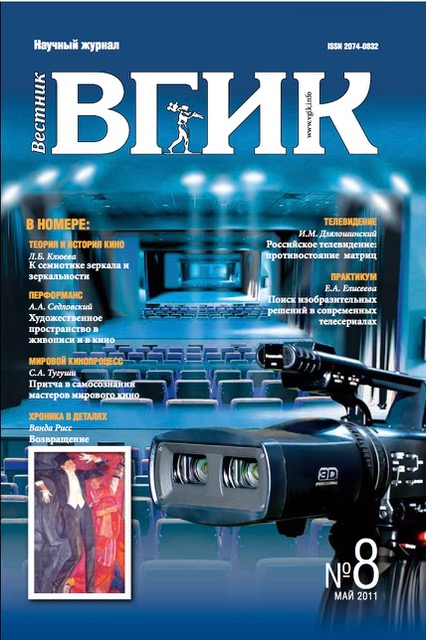Том 3, № 2 (2011)
- Год: 2011
- Статей: 16
- URL: https://journals.eco-vector.com/2074-0832/issue/view/898
- DOI: https://doi.org/10.17816/VGIK32
Статьи
О ГУМАНИТАРНЫХ ПРАКТИКАХ СОВРЕМЕННЫХ ЭКРАННЫХ ТЕХНОЛОГИЙ
Аннотация
Мультимедийность и мультиплатформенность медиарынка как отличительная черта современного бытия значительно расширяют информационные возможности общества при использовании технических средств, основанных на экранной технологии. Это, однако, не снимает ряд противоречий в области гуманитарных практик, сложившихся в результате деятельности массмедиа. В статье рассматривается проблема взаимосвязи технологических инноваций, смысловых и ценностных ориентиров в контексте множащегося экранного контента, прослеживается зависимость гуманитарных категорий от социальных потребностей.
Вестник ВГИК. 2011;3(2):74-83
 74-83
74-83


БИБЛИОТЕКА ВГИК
Вестник ВГИК. 2011;3(2):84-84
 84-84
84-84


БИБЛИОТЕКА ВГИК
Вестник ВГИК. 2011;3(2):151-151
 151-151
151-151


 152-153
152-153


ТЕОРИЯ И ИСТОРИЯ КИНО | ЭКРАННЫЕ ИСКУССТВА
 6-16
6-16


КИНОЯЗЫК И ВРЕМЯ | ГЕНЕЗИС ОБРАЗА
ДЖОТТО: ОТКРЫТЫЕ КУБЫ, МАЛЕНЬКИЕ ГЛУБИНЫ И ОСОБОЕ ПОВТОРЕНИЕ
Аннотация
В статье анализируется образность Джотто ди Бондоне, ее роль в формировании ренессансной репрезентационной традиции. Выстраивая «архитектурные кубы», создавая пространственную паузу, межфигурные отношения, человеческую событийность в межобразном взаимодействии (образ-событие), интимность, неуравновешенную и разорванную перспективу, а также повторяя определенный тип лица, - Джотто бессознательно формулирует в пластической форме, в новой образной стратегии идею индивидуальности.
Вестник ВГИК. 2011;3(2):18-23
 18-23
18-23


ХУДОЖЕСТВЕННЫЕ АМБИЦИИ ЭКРАННОГО ДОКУМЕНТА НА РУБЕЖЕ ВЕКОВ
Аннотация
В статье (окончание, начало в № 7) рассматривается особое направление в мировой документалистике рубежа XX и XXI веков - художественный авторский фильм на примере творчества ведущих мастеров К. Маркера, В. Херцога, Г. Реджио, В. Вендерса. Текст является частью большого исследования, посвященного истории зарубежного документального кино.
Вестник ВГИК. 2011;3(2):24-44
 24-44
24-44


МИФЫ И ШТАМПЫ ДОВОЕННОГО АМЕРИКАНСКОГО КИНО
Аннотация
Работа посвящена исследованию популярных драматических коллизий Ж.Польти, на основании которых делаются выводы о психологической истории довоенного американского кино. По результатам частотного анализа пятидесяти самых кассовых фильмов Америки 30-х годов в статье рассматриваются мифы и киноштампы довоенной Америки. Драматическая ситуация №12 «Достижение» находит свое отражение в мифе об «американской Золушке», который, однако, является кривым зеркалом популярного киносюжета.
Вестник ВГИК. 2011;3(2):45-56
 45-56
45-56


ПЕРФОРМАНС | ИСКУССТВО ВОПЛОЩЕНИЯ
ХУДОЖЕСТВЕННОЕ ПРОСТРАНСТВО В ЖИВОПИСИ И В КИНО
Аннотация
Кинематограф является синтетическим искусством, вобравшим в себя опыт ряда искусств, в том числе изобразительного. В статье рассматриваются некоторые аспекты влияния живописи на изобразительное решение фильма в плане построения глубины пространства кадра, использования законов линейной, воздушной и тональной перспективы, светового и цветового решения.
Вестник ВГИК. 2011;3(2):58-64
 58-64
58-64


НАТЮРМОРТ В ПРОСТРАНСТВЕ ФИЛЬМА
Аннотация
В статье рассматривается роль натюрморта в изобразительном решении художественного фильма. Анализируются возможные способы использования предмета в кинематографическом пространстве, выделяются две основные тенденции - семантическая и изобразительная. Предмет (или натюрморт как совокупность предметов) рассматривается как один из элементов, создающих образную среду фильма. Материалом исследования стали отечественные фильмы 1960 - 1980-х годов.
Вестник ВГИК. 2011;3(2):65-72
 65-72
65-72


МИРОВОЙ КИНОПРОЦЕСС | АНАЛИЗ
ПРИТЧА В САМОСОЗНАНИИ МАСТЕРОВ МИРОВОГО КИНО
Аннотация
В статье рассматривается кинопритча как жанр кинематографа, причины ее возрождения, а также основания для обращения к ней режиссеров ХХ столетия разных национальных киношкол, обосновывается философско-эстетическая основа этого жанра, роль притчи в эволюции киномысли.
Вестник ВГИК. 2011;3(2):88-98
 88-98
88-98


КИНОИСКУССТВО ИРАНА XX ВЕКА (1900-1980 гг.)
Аннотация
Начиная с первого десятилетия XX века, в Иране появляется новое искусство - кинематограф, в котором были взлеты и падения. Однако подлинное развитие киноискусства, с отражением национальной специфики и богатой культуры Ирана, происходит лишь в 1970-е годы, с приходом в кино нового поколения кинематографистов.
Вестник ВГИК. 2011;3(2):99-108
 99-108
99-108


ТЕЛЕВИДЕНИЕ | ЦИФРОВАЯ СРЕДА
РОССИЙСКОЕ ТЕЛЕВИДЕНИЕ: ПРОТИВОСТОЯНИЕ МАТРИЦ
Аннотация
В статье рассматриваются вопросы, связанные с анализом влияния глубинных институциональных, культурных и коммуникационных матриц на функционирование российских СМИ и телевидения как наиболее массового и влиятельного ресурса общественной коммуникации. Выявлена связь между институциональными матрицами, определяющими жизнь общества в целом, коммуникационными матрицами, регулирующими социальную коммуникацию, и медиаматрицами, задающими рамки профессиональной деятельности в сфере телевидения.
Вестник ВГИК. 2011;3(2):110-122
 110-122
110-122


 123-134
123-134


ПРАЗДНИК КИНО
ПРАЗДНИК КИНО. 33 Московский международный кинофестиваль 23.06 - 02.07.2011
Вестник ВГИК. 2011;3(2):4-4
 4-4
4-4


ПРАКТИКУМ | УРОКИ МАСТЕРСТВА
ПОИСК ИЗОБРАЗИТЕЛЬНЫХ РЕШЕНИЙ В СОВРЕМЕННЫХ ТЕЛЕСЕРИАЛАХ
Аннотация
В отечественном кино в 1990-х годах - первом десятилетии ХХI века прослеживается попытка поддержки такого вида кинематографа, как телевизионное кино. В этот период телевидение чаще, чем полнометражное кино, дает возможность кинематографистам проявить свое мастерство. По сути, именно телесериалы позволили сохранить традиции отечественной художественной школы в подходах к изобразительному воплощению на экране исторического материала.
Вестник ВГИК. 2011;3(2):136-150
 136-150
136-150













